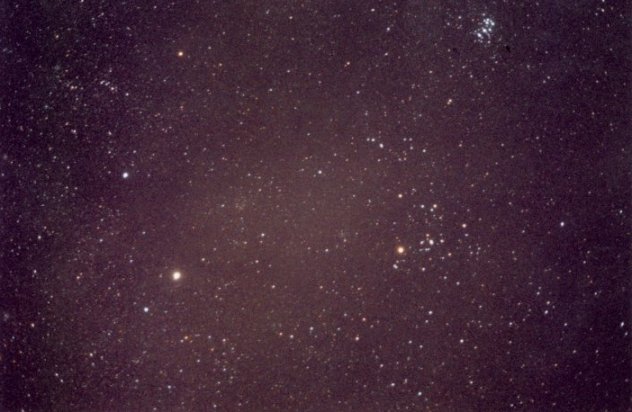THE ADMIRABLE BULL
Deep Taurus
Story and Photo by Jim Kaler

As northern spring turns to summer, Taurus is overtaken by the Sun
to wait his perpetual return to autumn skies. To those who say
that constellations never resemble their names, show the the sky's
great Bull, which you can also use to point out much real
astronomy. Imagine him staring down at you with his vee-shaped
head, made of the Hyades. Only 150 light years away, and one of
the closest open clusters to the Earth, the Hyades is also rather on the old side, born a bit over
half a billion years ago. Making the Bull's glaring eye and
appearing to be part of the cluster is first magnitude Aldebaran. The alignment is quite accidental,
as this dying orange giant star is but 65 light years away, less
than half the Hyades' distance. Toward the top of the picture and
three times farther than the Hyades is the beloved Pleiades, or Seven-Sisters, a much
younger (130 million years) cluster that still retains its high-
mass blue class B stars, which give it its wondrous sparkle.
Taurus's two horns stretch to the left, Saturn gracing the southern
one, Zeta Tauri (a well-known rapidly rotating "Be" star with a
circumstellar ring). The planet lies near the Crab Nebula (not
visible here), the remnant of the great supernova of 1054. On the
line between Aldebaran and the northen horn (Beta Tauri) lie much
more distant and fainter clusters, from right to left NGC 1647
(1800 light years away, 140 million years old) and "NGC 1746,"
which does not seem to exist and is actually made of two
overlapping clusters, NGC 1750 (2100 light years distant) and NGC
1758. The Milky Way near the anticenter to the Galaxy shines
dimly, providings a faint backdrop for the star-forming Taurus-
Auriga dark clouds.
To see a labelled image, push the star:

Copyright © James B. Kaler, all rights reserved.
These contents are the property of the author and may not be
reproduced in whole or in part without the author's consent
except in fair use for educational purposes. First published in
the May/August 2003 Newsletter of the Lowestoft and Great Yarmouth
Regional Astronomers, who are gratefully acknowledged.


